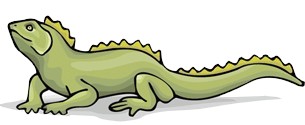 31-1 Reptiles
31-1 Reptiles
1. A reptile is a __________________
that has dry, scaly skin, lungs, and terrestrial ________________ with several
membranes.
2. The body covering of reptiles (scales) helps to prevent what? _______________________
3. What is the disadvantage of having scaly skin? _________________
Evolution of Reptiles
4. The fossil of the first known
reptile dates back to the ________________________ period.
5. What does the word "dinosaur" translate to? ______________________________________________
6. The Mesozoic period is also known as the ________________________________________
7. What dinosaur is known to have traveled in family groups? ____________________________
8. What branch of dinosaurs lead to modern birds? ______________________________________
9. In what period did the dinosaurs become extinct? ________________________________
How many millions of years ago? ______
Form and Function in Reptiles
10. List seven adaptations that have
contributed to the success of reptiles on land:
______________________________ ________________________________
______________________________ ________________________________
______________________________ ________________________________
______________________________
11. Ecotherms rely on ______________________to
control their body temperature.
12. Name a herbivorous reptiles: ______________________ A carnivorous reptile:
_____________________
13. Reptiles breathe using [ lungs / gills / both lungs and gills ]
14. Several species of crocodiles have flaps of skin that separate the mouth
from the nasal cavity, this allows them to _________________________________________________________
15. Reptiles have [ single / double / triple ] loop circulation.
16. Reptile hearts have two ____________________ and one or two ______________________
17. What reptile has a four chambered heart? _____________________________
18. Urine is produced by the ______________________________
19. Reptiles that live in water excrete their wastes in the form of ___________________________
and must drink a large amount of ______________________.
20. Land reptiles convert ammonia to _________________________; this helps them
to conserve _________
21. Most reptiles have a pair of sensory organs in the roof of their mouth that
can
____________________________________________ when reptiles flick their tongues
22. Because the legs of reptiles are rotated further under the body, reptiles
can ________________________
23. Reptiles reproduce by [ internal / external ] fertilization.
24. An oviparous reptile lays eggs that ________________________________________
An ovoviviparous reptile has young that are _________________________________
25. What type of egg do reptiles have? ___________________________________________
26. See Figure 31-8 "The Amniotic
Egg" - Match the structure with the function
________ Allantois a. regulates the transport of oxygen
________ Amnion b. food supply
________ Chorion c. fluid filled sac surrounding the embryo
________ Yolk Sac d. stores waste
27. See Figure 31-4 to label the turtle.

Groups of Reptiles
28. What are the four surviving groups
of reptiles?
________________________________________________________________________________
29. Lizards and snakes belong to the Order ____________________________________
30. What lizard produces venom? _________________________________
31. What type of snake can become very large (named in the book) _____________________________
32. What are the four types of Crocodilia? _________________________________
33. Where are alligators found? ___________________________________
34. Members of the Order Testudines that live in water are called ____________________________;
Those that live on land are called _________________________________
Those that live in salty water are called _____________________________
35. The dorsal part of the turtle's shell is called the ____________________________________
The ventral part of the shell is called the _______________________________________
36. Where is the tuatara found? ______________________________________
37. How are tuataras different from other lizards? _______________________________________________
Ecology of Reptiles
38. Why are many reptiles in danger?
____________________________________________
39. What products can be made from reptile skin? __________________________________________
40. Sea turtle recovery programs help turtles by:
a. bringing their eggs to an incubation station b. rescuing adult turtles from
nets
c. raising baby turtles in zoos d. forcing turtles back into the ocean